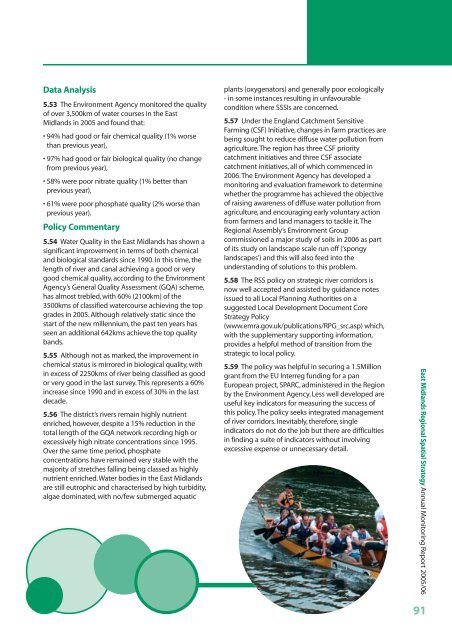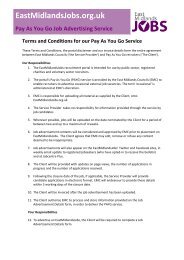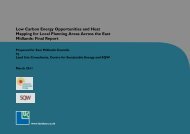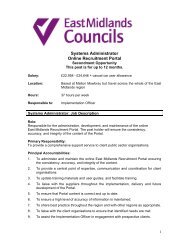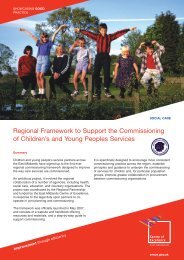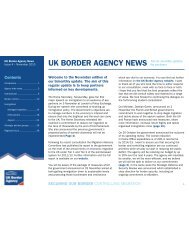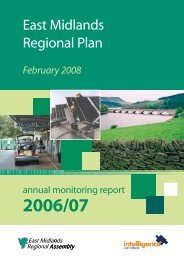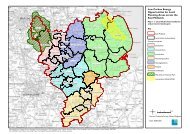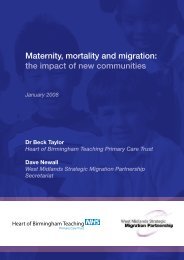East Midlands Regional Spatial Strategy 2005/06
East Midlands Regional Spatial Strategy 2005/06
East Midlands Regional Spatial Strategy 2005/06
Create successful ePaper yourself
Turn your PDF publications into a flip-book with our unique Google optimized e-Paper software.
Data Analysis<br />
5.53 The Environment Agency monitored the quality<br />
of over 3,500km of water courses in the <strong>East</strong><br />
<strong>Midlands</strong> in <strong>2005</strong> and found that:<br />
• 94% had good or fair chemical quality (1% worse<br />
than previous year),<br />
• 97% had good or fair biological quality (no change<br />
from previous year),<br />
• 58% were poor nitrate quality (1% better than<br />
previous year),<br />
• 61% were poor phosphate quality (2% worse than<br />
previous year).<br />
Policy Commentary<br />
5.54 Water Quality in the <strong>East</strong> <strong>Midlands</strong> has shown a<br />
significant improvement in terms of both chemical<br />
and biological standards since 1990. In this time, the<br />
length of river and canal achieving a good or very<br />
good chemical quality, according to the Environment<br />
Agency’s General Quality Assessment (GQA) scheme,<br />
has almost trebled, with 60% (2100km) of the<br />
3500kms of classified watercourse achieving the top<br />
grades in <strong>2005</strong>. Although relatively static since the<br />
start of the new millennium, the past ten years has<br />
seen an additional 642kms achieve the top quality<br />
bands.<br />
5.55 Although not as marked, the improvement in<br />
chemical status is mirrored in biological quality, with<br />
in excess of 2250kms of river being classified as good<br />
or very good in the last survey.This represents a 60%<br />
increase since 1990 and in excess of 30% in the last<br />
decade.<br />
5.56 The district’s rivers remain highly nutrient<br />
enriched, however, despite a 15% reduction in the<br />
total length of the GQA network recording high or<br />
excessively high nitrate concentrations since 1995.<br />
Over the same time period, phosphate<br />
concentrations have remained very stable with the<br />
majority of stretches falling being classed as highly<br />
nutrient enriched.Water bodies in the <strong>East</strong> <strong>Midlands</strong><br />
are still eutrophic and characterised by high turbidity,<br />
algae dominated, with no/few submerged aquatic<br />
plants (oxygenators) and generally poor ecologically<br />
- in some instances resulting in unfavourable<br />
condition where SSSIs are concerned.<br />
5.57 Under the England Catchment Sensitive<br />
Farming (CSF) Initiative, changes in farm practices are<br />
being sought to reduce diffuse water pollution from<br />
agriculture.The region has three CSF priority<br />
catchment initiatives and three CSF associate<br />
catchment initiatives, all of which commenced in<br />
20<strong>06</strong>.The Environment Agency has developed a<br />
monitoring and evaluation framework to determine<br />
whether the programme has achieved the objective<br />
of raising awareness of diffuse water pollution from<br />
agriculture, and encouraging early voluntary action<br />
from farmers and land managers to tackle it.The<br />
<strong>Regional</strong> Assembly’s Environment Group<br />
commissioned a major study of soils in 20<strong>06</strong> as part<br />
of its study on landscape scale run off (‘spongy<br />
landscapes’) and this will also feed into the<br />
understanding of solutions to this problem.<br />
5.58 The RSS policy on strategic river corridors is<br />
now well accepted and assisted by guidance notes<br />
issued to all Local Planning Authorities on a<br />
suggested Local Development Document Core<br />
<strong>Strategy</strong> Policy<br />
(www.emra.gov.uk/publications/RPG_src.asp) which,<br />
with the supplementary supporting information,<br />
provides a helpful method of transition from the<br />
strategic to local policy.<br />
5.59 The policy was helpful in securing a 1.5Million<br />
grant from the EU Interreg funding for a pan<br />
European project, SPARC, administered in the Region<br />
by the Environment Agency. Less well developed are<br />
useful key indicators for measuring the success of<br />
this policy.The policy seeks integrated management<br />
of river corridors. Inevitably, therefore, single<br />
indicators do not do the job but there are difficulties<br />
in finding a suite of indicators without involving<br />
excessive expense or unnecessary detail.<br />
<strong>East</strong> <strong>Midlands</strong> <strong>Regional</strong> <strong>Spatial</strong> <strong>Strategy</strong> Annual Monitoring Report <strong>2005</strong>/<strong>06</strong><br />
91


